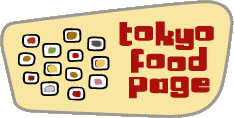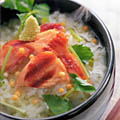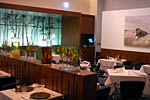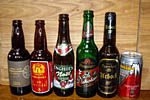| ||||||||||||||||||
| ||||||||||||||||||
| basic information |
Japanese cuisine offers a great variety of dishes and regional specialties. Some of the most popular Japanese and Japanized dishes are listed below.
We have categorized them into rice dishes, seafood dishes, noodle dishes, nabe dishes, soya bean dishes, yoshoku dishes and other dishes. Please note that some dishes may fit into multiple categories, but are listed only once.
 | H.I.S. Experience Japan Tours Make Your Own Sushi Learn how to make sushi, make sushi by yourself and taste the sushi. |
For over 2000 years, rice has been the most important food in Japanese cuisine. Despite changes in eating patterns over the last few decades and slowly decreasing rice consumption in recent years, rice remains one of the most important ingredients in Japan today, and can be found in numerous dishes.
 | Rice Bowl A bowl of plain cooked rice is served with most Japanese meals. For breakfast, it is sometimes mixed with a raw egg and soya sauce (tamago kake gohan) or enjoyed with natto or other toppings. |
 | Sushi more information Sushi can be defined as a dish which contains sushi rice, cooked rice that is prepared with sushi vinegar. There are various kinds of sushi dishes. |
 | Domburi more information A bowl of cooked rice with some other food put on top of the rice. Some of the most popular toppings are tempura (tendon), egg and chicken (oyakodon), tonkatsu (katsudon) and beef (gyudon). |
 | Onigiri Onigiri are rice balls made of cooked rice and usually wrapped in nori seaweed. They are slightly salted and often contain some additional food in the center, for example an umeboshi (pickled Japanese plum), katsuobushi (dried bonito shavings), tuna or salmon. Rice balls are a popular and inexpensive snack available at convenience stores. |
 | Kare Raisu Kare Raisu (Curry Rice) is cooked rice with a curry sauce. It can be served with additional toppings such as tonkatsu. Curry is not a native Japanese spice, but has been used in Japan for over a century. Kare Raisu is a very popular dish, and many inexpensive Kare Raisu restaurants can be found especially in and around train stations. |
 | Fried Rice Fried rice or chahan has been originally introduced from China. A variety of additional ingredients such as peas, egg, negi (Japanese leek) and small pieces of carrot and pork are mixed into the rice when stir fried. It is a suitable dish for using left over rice. |
 | Chazuke Chazuke is a bowl of cooked rice with green tea and other ingredients, for example, salmon or tarako (cod roe) added to it. It is a suitable dish for using left over rice. |
 | Kayu Kayu is rice gruel, watery, soft cooked rice that resembles oatmeal. It is a suitable dish for using left over rice and is often served to sick people because it can be digested easily. |
 | Sashimi more information Sashimi is raw seafood. A large number of fish can be enjoyed raw if they are fresh and prepared correctly. Most types of sashimi are enjoyed with soya sauce and wasabi. |
 | Yakizakana Yakizakana means grilled fish. Many varieties of fish are enjoyed in this way. |
 | Soba more information Soba noodles are native Japanese noodles made of buckwheat flour or a mixture of buckwheat and wheat flour. Soba are about as thick as spaghetti. They can be served cold or hot and with various toppings. |
 | Udon more information Udon noodles are native Japanese noodles made of wheat flour. Udon are thicker than soba and can also be served either hot or cold and with various toppings. |
 | Ramen more information Ramen are Chinese style noodles prepared in a soup with various toppings. Ramen is one of the many popular dishes that were originally introduced from China but have become completely Japanized over time. |
 | Somen Like Udon noodles, somen are Japanese noodles made of wheat flour, but they are much thinner than Udon and Soba. Somen are usually eaten cold and are considered a summer speciality. |
 | Yakisoba Yakisoba are fried or deep fried Chinese style noodles served with vegetables, meat and ginger. |
Nabe dishes or hot pot dishes are prepared in a hot pot, usually at the table. Typical ingredients are vegetables such as negi (Japanese leek) and hakusai (Chinese cabbage), various mushrooms, seafood and/or meat. There are many regional and personal varieties, and they are especially popular in the cold winter months. Some special nabe dishes are:
 | Oden A nabe dish prepared with various fish cakes, daikon, boiled eggs, konyaku and kombu seaweed, boiled over many hours in a soya sauce based soup. |
 | Sukiyaki A nabe dish prepared with thinly sliced meat, vegetables, mushrooms, tofu and shirataki (konyaku noodles). The pieces of food are dipped into a raw egg before eaten. |
 | Shabu-Shabu Shabu-shabu is Japanese style meat fondue. Thinly sliced meat, along with vegetables, mushrooms and tofu is dipped into a hot soup and then into ponzu vinegar or a sesame sauce before being eaten. |
 | Chanko Nabe Chanko nabe is traditionally the staple diet of sumo wrestlers. There are many varieties of chanko nabe. A few chanko nabe restaurants can be found around Ryogoku, the sumo district in Tokyo. |
 | Yakitori more information Yakitori are grilled chicken pieces on skewers. Most parts of the chicken can be used for yakitori. |
 | Tonkatsu Tonkatsu are deep fried pork cutlets. Tonkatsu is usually served with shredded cabbage or on top of cooked rice (katsudon) or with Japanese style curry rice (katsu kare). |
 | Nikujaga more information Nikujaga is a popular dish of home style cooking made of meat (niku) and potatoes (jagaimo). |
Tofu, natto, miso and many other important ingredients of Japanese cooking are made of soya beans. The following are some of the most popular soya bean based dishes:
 | Yudofu Yudofu are tofu pieces boiled in a clear, mild soup and dipped into a soya based sauce before being eaten. |
 | Agedashi Tofu Agedashi Tofu are deep fried tofu pieces that are dipped into a soya based sauce before being eaten. |
 | Miso Soup A bowl of miso soup often accompanies breakfast, lunch and dinner. It is made by dissolving miso paste in hot water and adding additional ingredients such as wakame seaweed and small pieces of tofu. |
 | Korokke more information Korokke has its origins in the croquettes which were introduced to Japan in the 19th century. Korokke are breaded and deep fried, and come in many varieties depending on the filling. The most common filling is a mix of minced meat and mashed potatoes. |
 | Omuraisu Omuraisu (abbreviation for omelet rice) is cooked rice, wrapped in a thin omelet, and usually served with a gravy sauce or tomato ketchup. |
 | Hayashi Raisu Hayashi rice is Japanese style hashed beef stew, thinly sliced beef and onions in a demi-glace sauce served over or along side cooked rice. It resembles kare raisu, and, like kare raisu, it is also eaten with a spoon. |
 | Hamubagu Hamubagu is a Japanese style hamburger steak. It is typically served on a plate and usually with a demi-glace sauce, but without a bun. |
 | Tempura more information Tempura is seafood, vegetables, mushrooms and other pieces of food coated with tempura batter and deep fried. Tempura was introduced to Japan by the Portuguese in the 16th century, but has become one of Japan's most famous dishes internationally. |
 | Okonomiyaki more information Okonomiyaki is a mix between pizza and pancake. Various ingredients such as seafood, vegetables and meat can be mixed with the dough and placed on the okonomiyaki as topping. |
 | Monjayaki Monjayaki is a Kanto region specialty that is similar to Okonomiyaki, however, the dough used is much more liquid than the okonomiyaki dough. |
 | Gyoza more information Gyoza are dumplings with a filling usually made of minced vegetables and ground meat. Gyoza were introduced to Japan from China. In Japan gyoza are usually prepared by frying them. |
 | Chawanmushi Chawanmushi is savory steamed egg custard that usually contains pieces of chicken, shrimp, fish cake and a ginko nut mixed inside. |
 | Tsukemono Tsukemono are Japanese pickles. There are many variety of pickles, and a small dish of tsukemono is usually served with Japanese meals. |
Any advice or questions? Voice them in the forum!
| product links |
 |
|






